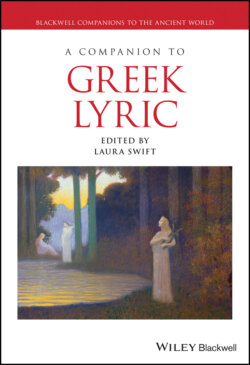Читать книгу A Companion to Greek Lyric - Группа авторов - Страница 35
V Alcaeus’ Epic Lesson: Damning Pittacus
ОглавлениеA less exculpatory purpose can be seen in Alcaeus’ “Cologne fragment” (fr. 298), which compares his contemporary Mytilenaean Pittacus to the lesser Aias and his sacrilegious behavior—specifically the rape of Priam’s daughter Cassandra at the altar of Athene herself—during the sack of Troy.25 Here Alcaeus still copies some epic phraseology (16 λ]ύ̣σσαν … ὀλόαν ἔχων ~ λύσσαν]ν ἔχων ὀλοήν “with destructive madness” Il. 9.305; lines 25–6 κὰ̣τ οἴνοπα / … πόν]τ̣ο̣[ν] ~ ἐπὶ οἴνοπα πόντον “over the wine-faced sea” found 17x in Homer in several cases),26 though it is more noticeable that he uses competing “lyric” coinages (8 πολυλάιδος and 24 γόργωπι]ν) while avoiding any of the many standard epic epithets for the ever-present Athena. The meter, too, signals its lyric distinctiveness: the Alcaic stanza, composed of four identical verses, is somewhat like the dactylic hexameter in each of its verses admitting degrees of end-stopping (note, e.g., 4 and 5), while as a whole it is, once more, a semantic unit with, for example, the run-over between stanzas 3 and 4 underlining the destruction of Troy therein denoted.
The comparison with Pittacus is made later in the poem (addressed as “son of Hyrrhas” at line 47), and the myth itself is a refraction of a tale probably already in epic form: the story is known to the Odyssey poet (3.145–146, 4.502), as is the consequently difficult nostos facing the Greek heroes from Troy (Od. 1.325–7). Later ages knew an actual narrative from a cyclic poem, the Iliou Persis (“Destruction of Troy”) though there is no way to tell how it must have been narrated in an epic mode, beyond the obvious differences in meter and dialect, except that its progress would have been likely more sequential and leisurely.27 Direct influence may be suspected, but impossible to pinpoint: interestingly, both Homer and Alcaeus give the story in a somewhat allusive manner, the former poem perhaps to avoid the picture of a too-hostile Athene the Lesbian because of the point he wishes the story to make—that divine revenge for individual wrongdoing must be avoided before it affects the entire community.
The extant portion of fr. 298 seems itself to be a miniature epic, with stanzas 1 and 2 drawing the mythical lesson in a proemic manner (the Greeks would have found a calmer sea had they killed the “man who harmed the god” 5), before the poet embarks on the narrative portion of the poem telling the story of that wrongdoing (stanza 3 ff.). The myth may have continued to the general debate over what to do about Aias (see esp. 30), but the rest of the poem cannot be reconstructed after v. 27. Again, we find density, complexity, and allusivity: after an abrupt introduction, Aias is first merely “the one who harmed the god” (5), Cassandra is not named (8) or rather denoted in such a way as to connect her with the “cries of the children” in the city (14); and without further ado, Deiphobus stands for the Trojans’ original, disastrous error. The parallel of Cassandra and Aias in the third and fifth stanzas, with the latter named and the former’s name merely alluded to, places great emphasis on the depiction of what is happening in Troy in the intervening stanza (11, 12–15), underlining the example of the people’s suffering for one man’s transgression (Deiphobus, though τ, ἄμα in 12 suggests another name at the start of the verse). Thus the inner story of (Trojan) popular suffering is made to bolster the outer (Greek) one as well.
